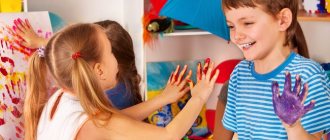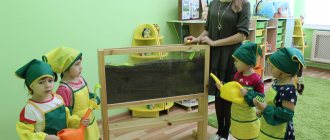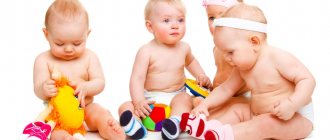Every parent wants their child to “speak” quickly, so that his speech is correct and beautiful. Next to a “talking” child, life seems more fun, more varied, and it is pleasant to tell friends about the first words and phrases uttered by the baby. In addition, developed speech is an indicator of the correct development of the child.
How to help your baby's speech development? We offer several simple techniques, some of which you probably already use, consciously or intuitively. We hope that you will be able to gain some new ideas for yourself.
Sing songs to your baby throughout the day (children and adults).
From the very first months of life, it is extremely important to sing songs to your baby. Singing combines words, their meaning and rhythm - and this is exactly what we need for the harmonious development of speech. And a song sung by a mother or another loved one is often sung not far from the child, and he sees the face of the singer, his lips, facial expressions, and emotions. All this contributes to the full perception of melody, rhythm and words.
It is very important for an adult to sing, and not to play recordings of songs, even when it seems that there is no hearing or voice. You don’t even have to sing, just recite the words of the verse in a chant manner, slowly. The main thing here is that the rhythm matches and that the baby likes it.
Write your own poems and stories (for mothers of children from 1.5 years old)
Composing your own songs and poems is very easy and simple! This will help us not only develop the child’s speech, but also tune in to the game, captivate or distract the baby at the right time. If, for example, you are getting ready to sit down to draw and pour some water into a saucer, sing: “We’ll go now, we’ll bring some water.” Or on a walk: “Our Masha was walking, Masha found a twig!”
Talk to your child as if you were an adult.
Long before the active speech period, the child develops a general idea of speech and his native language. After all, he hears our speech every day - how we talk to each other, ask or answer questions, hum a song under our breath or talk on the phone...
It is very important to talk a lot with the child and in front of the child, and often turn directly to the baby himself (even if it seems that he still does not understand anything). Let your speech be quite simple and accessible, but at the same time correct, “adult”. You should not try to simplify words and replace them with onomatopoeia (for example, “yoke-go” instead of “horse”), because then you will have to retrain your child back to “full-fledged” words.
Act out dialogues between toys in the presence of your baby.
Even for the youngest children we can arrange dialogues with toys. Attract the child's attention, go up to the doll and say:
- “Hello doll! What is your name?"
- "My name is Masha"
- "Hello. Masha! And I’m Olya’s mother.”
- “Hello, mom Olya! And who is this?"
- “And this is our girl Nastenka”
And in this spirit, we can depict a small dialogue between the doll and the child, connect another toy or one of the relatives. The conversation lasts a very short time, and the child has time to rejoice that the doll has suddenly come to life. This technique helps to diversify our games, involve the child in them and show how dialogue is built.
Play rhythm music games.
It has long been proven that the motor analyzer helps to connect the image of an object into a single whole. Therefore, when a child sees, hears, touches and moves at the same time, he better remembers objects, their properties and actions with them. This applies even more to speech development: the child’s own movement has a strong positive effect on speech development. This is especially true for hand movements and the development of fine finger movements. Orderly movement has a positive effect on the mental development of the child. It is important that the baby’s movements are rhythmic, simple and accessible.
Try taking wooden spoons and knocking on each other. Instead of a drum, so that the sound is not so harsh, take a box or plastic bowl. You can also use a regular rattle, clap your hands or stomp your feet. And while humming any song, tap the rhythm.
Speech skills of children from one to two years old: basic terms
From the age of one, a child begins to actively master speech, accumulating a passive vocabulary (words he knows) and an active one (words he pronounces). By the end of the second year, it includes up to 300 words, up to 75% of them are nouns, about 20% of them are verbs, the rest are adjectives, pronouns and other parts of speech:
The baby actively manipulates objects, assessing reactions to the actions of others, loves praise, showing emotions with his voice.
In year- At 14-15 months, he repeats syllables and monosyllabic words after adults, trying to fully convey intonation, while distorting the words (dya is yes, boo is buh).
- By 15 months, it is possible to construct the rudiments of sentences from two simplified words (the roots of the word are used), for example, kitty meow - kitty meows. Vocabulary consists of 5-7 words, understanding of simple speech instructions without gestures, can call family members, asks for help with gestures and sounds.
- By 1 year 4 months , pays attention to the emotions of other children, uses individual words, gestures and sounds, explaining his desires and actions. Can greet people he knows with joyful exclamations and actions, uses affirmative and negative words and gestures (yes and no), can bring toys by name, showing them.
- At one and a half years old, the dictionary has up to 20 words, can speak its own language, pronouncing a large number of syllables, collecting them in bizarre combinations, similar to words. Such speech chains are similar in intonation and rhythm to adult speech, accompanied by gestures and imitation of behavior. The child can repeat after his parents words of one or two syllables that are easy to pronounce - mother, woman, aunt. Also in speech he can pronounce a stressed syllable from the entire word or words with the same syllables. The most pronounced are vowel sounds - i-u-a-o, or consonants - b-p-m-g-k, soft ones - d-t-l-n-t-s. Can explain with simple syllables and gestures quite clearly to parents.
- By 1 year 8 months, the concepts of singular and plural numbers appear, and the endings of words end with different endings, repeats after adults words of two syllables and different letters that he already knows. Repeats gestures and sounds he sees, may be capricious and cry in order to get what he wants.
- At 1 year 10 months there are already sentences of two words, two-syllable words and three-syllable words. In speech, the first sounds or consonant endings may be omitted; by the age of two years, the active vocabulary includes up to 20 words.
Focus on games to develop fine motor skills.
Nature has arranged it in such a way that in our brain the areas responsible for hand movements and speech are located nearby and their development is closely connected. Therefore, the development of fine motor skills is, if not a “panacea,” then one of the important components of speech development.
We recommend the following games to develop your baby's fine motor skills:
- games where we hold small objects (pyramid rings, paper snowflakes)
- drawing and writing
- applique and modeling
- games with buttons and loops
- games with ribbons
- lacing games
- games with sticks (pry a cardboard fish with a stick and catch it)
- playing keyboard instruments
- simple finger games (it’s raining, tapping your fingers)
- games with clothespins
If a child speaks poorly or does not speak: reasons
If persistent speech disorders occur in childhood, they may be caused by various negative influences that acted in utero, during childbirth, or during the first months of life. These include:
the influence of heredity with the presence of mental retardation and mental illness, sudden changes in metabolic processes, hormonal problems and speech defects in the parents themselves- complications during pregnancy
- difficult birth with complications and obstetric interventions that led to head injuries and fetal asphyxia
- negative effects on health in early childhood, up to two years of age
- the influence of the environment in which the child communicates, if he is influenced by long-term psychologically traumatic circumstances, stress, improper upbringing and pedagogical neglect
- bilingual, multilingual families in which speech acquisition occurs later, but in parallel in several languages.
In short, any influences that, one way or another, affect the central nervous system and the cerebral cortex, the connections formed between the speech apparatus and speech centers, affect the time of development of speech skills and their characteristics.
Organic pathologies of the brain affect speech most severely - cysts, hemorrhages, tumors, underdevelopment of brain areas, as well as inflammatory, hypoxic and other lesions. Problems with the middle ear and frequent otitis media, chronic diseases, and problems with the development of the dentofacial apparatus are dangerous for the development of speech. Injuries to the jaws and teeth and thumb sucking are dangerous.
Play finger games.
Finger games are one of the options for games for fine motor skills, and in combination with funny rhymes and nursery rhymes, they can be a good help in the development of speech. For example, here is a good game for you and your baby, which develops fingers and allows us to communicate. You yourself “walk” with your fingers on the floor or table and say at the same time:
Hush, hush, hush, hush!
Mice come out for a walk!
And behind them is a red cat,
Paw - clap!
And then with your other hand you catch the “mice” by slapping them. The “mice,” of course, are trying to escape, well, there’s someone who’s going to win! The child usually immediately joins the game and has a lot of fun. In this funny game, many skills that are useful for mastering speech are seriously developed: hand motor skills, attention, reaction, sense of rhythm, and most importantly, the desire to communicate with an adult in the game.
These are not all, but some of the most effective and simple techniques available to any mother. How many of them do you have in your arsenal? Write in the comments and share your ideas and know-how.
Happy games and joyful communication between you and your baby!
Source
Speech skills of children under one year old: basic terms
In the first year of life, the formation of pre-speech skills, which occurs in a certain sequence, lays the further foundation for further speech development. There are certain monthly indicators that reflect the dynamics of changes, these include:
- At the age of up to one and a half months, reflex sounds and screams accompany various reactions of the baby to pain, hunger, touching objects or other irritants. The cry consists of a predominance of vowel sounds with nasal tones.
- From 1.5-2 months, attempts at humming and pronunciation of guttural vowel sounds are gradually formed.
- From 2 to 5 months, a qualitative restructuring of communication gradually occurs, emotional discordant screaming and laughter, confident humming in different tones, and hooting appear.
- At the age of about 4 months, the vowel sounds a-u-y are pronounced, often in combination with g. Emotional complexes of revival and laughter in response to various actions of the parents are characteristic.
- Closer to 5 months, the humming is already quite differentiated, with a directional sound and melodious.
- During the period of six months , the first babble appears, the manifestation of interest in objects and people in the gaze and attempts to express emotions with sounds and intonation. Both positive and negative manifestations of sounds, whimpers, exclamations, and squeals are possible. The child can already convey intonations in the voice quite well by changing the strength of the sound and its tonality.
- By seven months, babbling speech appears and the pronunciation of individual syllables, which indicates a desire for joint games, such as focusing on familiar sounds, toys with musical accompaniment.
- By the age of eight months , a child reacts with different emotions to familiar and unfamiliar faces, and can pronounce chains of identical syllables - ba-ba-ba, ga-ga-ga, dyad-dya-dya, etc. Due to his movements and voice, he attracts the attention of his parents, he can pull his hands towards him with sounds, he understands the meaning of simple games of pats and hide and seek.
- By 9 months, attempts are made to fully communicate with gestures and sounds, accompanied by emotional coloring; from the same age, attempts are made to imitate the words of adults with repetition of sounds.
- At 10 months, the baby understands speech addressed to him depending on the situation, uses several babbling words that are correlated with situations, he actively expresses his mood with tone of voice and volume, changes in expression, and makes attempts to copy the facial expressions and intonations of his parents.
- By the period of 11-12 months , up to 5 babbling words are used that explain the situation, supplemented by gestures and sounds, intonations.








